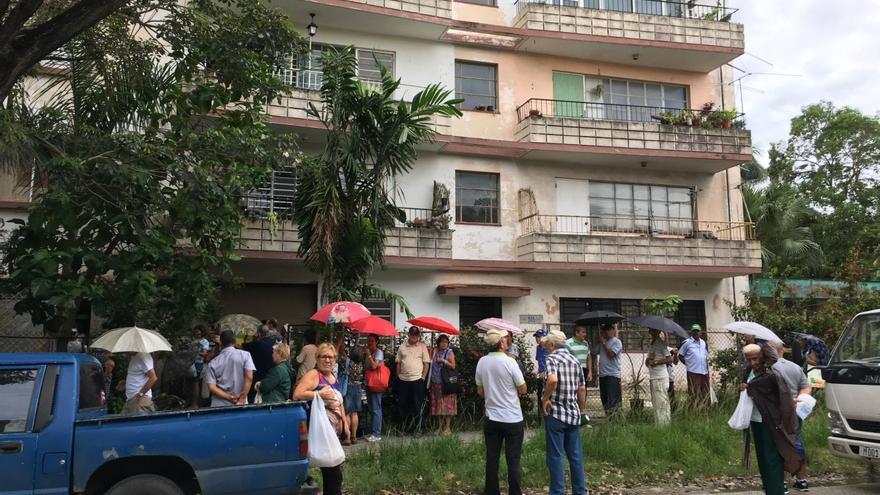
![]() 14ymedio, Zunilda Mata, Havana, 31 May 2018 — The first announcement of “Cookies for Sale!” was heard this Wednesday in Havana’s Los Sitios neighborhood, mobilizing dozens of neighbors. After more than a week of the state shops being empty and the black market paralyzed, the seller was greeted with relief, in a city where the storm Alberto has exacerbated the shortage of food.
14ymedio, Zunilda Mata, Havana, 31 May 2018 — The first announcement of “Cookies for Sale!” was heard this Wednesday in Havana’s Los Sitios neighborhood, mobilizing dozens of neighbors. After more than a week of the state shops being empty and the black market paralyzed, the seller was greeted with relief, in a city where the storm Alberto has exacerbated the shortage of food.
“The downpours came at a time when we already had problems,” Eduardo tells 14ymedio. Eduardo sells products in 17th and K agricultural market managed by the Youth Labor Army, which belongs to the armed forces and is made up of compulsory military service recruits.
“The last few weeks the supply of tubers and vegetables has not been good for several reasons, such as the controls on the roads over the trucks that bring products and the fines they are assessing,” says the merchant. “In this month of May very few farmers have been able to harvest anything from the fields because it doesn’t stop raining.”
Reality confirms Eduardo’s words. InSan Antonio de los Baños, Alquízar and Güira, three of the municipalities of Artemisa that supply the most agricultural products to the capital, the fields are waterlogged and all the harvests have stopped. “So there is no one working the land,” says Juan Carlos Ruíz, a producer of beans in Pulido, a local town.
“Working in these conditions is impossible, because most of the farmers in this area do not have waterproof boots, no raingear and no truck wants to haul the harvest out of the field with so much mud because it can get stuck,” Ruíz adds. “It’s not worth it to harvest anything, because then it just rots in the field.”
On the stands in the San Rafael agricultural market, one of the best stocked in the capital, the picture is not encouraging either. Zero fruits, few vegetables and little pork with a row of anxious buyers despite a price of 50 Cuban pesos per pound, the salary of two working days of a professional.
The market for rationed products has also suffered. This week the distribution of chicken on the ration book has begun in some of Havana’s municipalities, half a month late. Other areas are still waiting for the chicken to arrive; poultry is all that is available to Cuban adults who can’t claim special rations because of health problems, in a ration market where meat and fish were formerly also distributed.
Odalys Escandell García, vice minister of Internal Commerce, told the official media that they are working “to guarantee on-time distribution of the foods for the ’family basket’, social consumption and special diets in the territories affected by the heavy rains.”
As of May 28th the products included in the basic ration basket for the month of June began to be sold in advance: 7 pounds of rice, 4 pounds of sugar, 20 ounces of beans and half a pound of oil, but the measure has not been able to alleviate the needs. Although the authorities have said that the 4,602 centers of commerce and food service in Havana are functioning, many have empty shelves or very little merchandise.
This Thursday rationed potatoes also began to be sold in some state outlets but in several places visited by this newspaper the amount available was not enough to supply all the registered consumers. The distribution of eggs has been irregular, especially in neighborhoods on the periphery of the capital.
“It is not a question of not having supplies, but that many products had to be moved from the points of sale to stores or warehouses where they were more protected,” explains a source from the Ministry of Domestic Trade (Mincin), who preferred anonymity.
In the streets people are beginning to despair. “I have toured several agricultural markets to try to buy some taro roots because my mother can only eat puree, but there aren’t any,” a young woman on the outskirts of the 26th street market in the Plaza of the Revolution municipality said this Thursday morning.
Private businesses, from elegant paladares (private restaurants) to small food kiosks, offer bribes to get supplies. “There is no pizza or juice,” reads a poster on Infanta Street outside a small café run by two sisters.
The situation in the villages in the center of the island, where the waters caused serious flooding, is even worse. “We had to make do with what we had saved but we have lost part of the rice we had in sacks and also the corn flour,” explains Mario Pelayo, a resident of Sagua la Grande in Villa Clara, by telephone.
“The flooding has devastated the crops,” says the farmer. “Between what came from the Alacranes dam and the river that crosses the city that overflowed, here most of the neighbors have been left with very little and the bakeries have not worked for days,” says Pelayo.
“People are waiting for some food to be delivered but still nobody has come here to give us anything,” he says.
____________________________
The 14ymedio team is committed to serious journalism that reflects the reality of deep Cuba. Thank you for joining us on this long road. We invite you to continue supporting us, but this time by becoming a member of 14ymedio. Together we can continue to transform journalism in Cuba.
